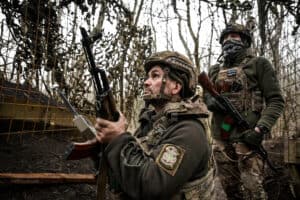Russia's defence ministry on Monday said that 63 Russian soldiers were killed in a strike.

Russia has acknowledged its worst ever military losses from a single Ukrainian attack with the death of at least 63 servicemen in Makiivka in eastern Ukraine over New Year.
Here is what we know about the strike:
What happened in Makiivka?
Russia’s defence ministry on Monday said in an extremely rare announcement that 63 Russian soldiers were killed in a strike carried out using Himars rocket systems supplied by the United States to Ukraine.
The strike happened in Makiivka, a small city in the region of Donetsk in a part of Ukraine that has been under the control of pro-Russian separatists since the beginning of the conflict in eastern Ukraine in 2014.
Russian defence ministry spokesman Igor Konashenkov did not give a date for the strike but said that four missiles had hit a “temporary deployment centre”.
This video is no longer available.
Two other rockets were shot down, he said.
It was the biggest ever loss in a single attack acknowledged by Moscow since it began its invasion in February.
It was also the first communication about any military deaths since September when Defence Minister Sergei Shoigu gave a toll of 5,937 soldiers killed.
What do the Ukrainians say?
Ukraine on Monday took responsibility for the strike and said it occurred on December 31 during a wave of Russian strikes on Ukrainian targets.
The Ukrainian army’s strategic communications department said that nearly 400 soldiers were killed and 300 injured in the strike in Makiivka.
But the general staff of Ukraine’s armed forces said it did not have a final toll and announced only that “up to 10 units of enemy military equipment” had been destroyed.
Why so many deaths?
The Russian army gave no reason for the high number of casualties. Ukrainian forces simply said there was a “concentration” of soldiers in Makiivka.
Russian and Ukrainian sources began reporting on the strike on Sunday, saying that Russian mobilised personnel – not professional soldiers – had been killed.
This video is no longer available.
A source from the separatist authorities told the Russian state news agency TASS that Ukrainians had been able to accurately target the building because of the “widespread use by the military who had just arrived of their mobile phones”.
Former separatist commander Igor Strelkov, who is familiar with the situation on the ground, said the building was “almost completely” destroyed because ammunition stored on the premises detonated in the strike.
He said “hundreds” had been killed and wounded.
What has been the reaction in Russia?
The announcement of the losses caused shock in Russia as well as criticism of Russia’s high command which has already been humiliated by a series of battlefield reversals in recent months.
“Despite several months of war, some conclusions have still not been drawn,” wrote the blogger Boris Rozhin, who is close to the separatists, criticising the “incompetence” of Russian high command.
Alexander Kots, a war correspondent, wrote: “Why do we keep putting up (the mobilised personnel) in hotels, hostels and professional schools?”.
This video is no longer available.
Strelkov said another deadly strike could happen “at any moment”, adding that Russian generals were “incapable of learning”.
The US-based Institute for the Study of War predicted Russia’s defence ministry would try to “deflect the blame for its poor operational security” onto local officials and mobilised personnel.
In a rare public commemoration, some 200 people gathered in the Russian city of Samara – where some of the victims came from – to commemorate the dead.
Mourners laid flowers at a city monument, an Orthodox priest recited a prayer for the dead and soldiers fired a gun salute.
This video is no longer available.






